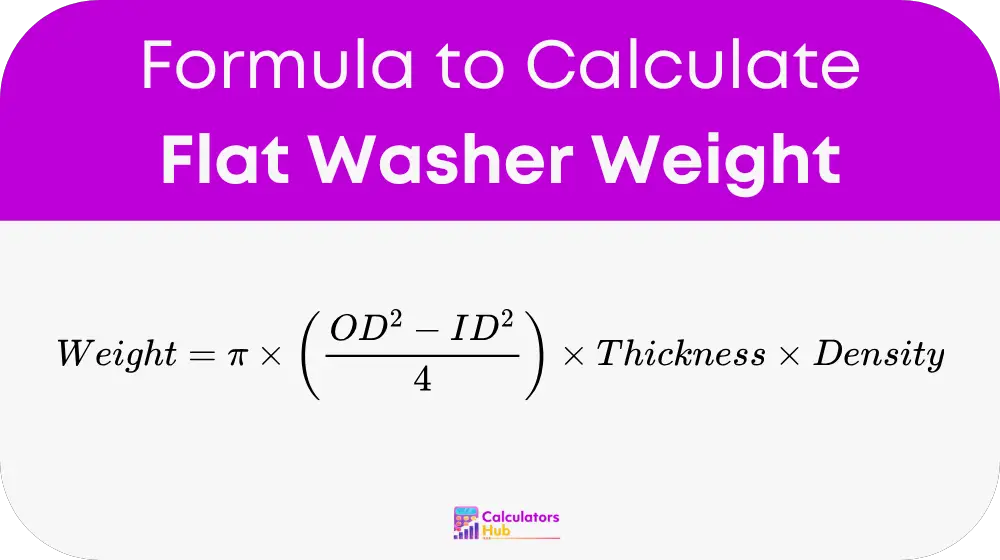The Flat Washer Weight Calculator estimates the weight of a flat washer based on its physical dimensions and material density. Flat washers are essential components in engineering, acting as load distributors and spacers in assemblies. Knowing their exact weight is critical in fields like logistics, shipping, mechanical design, and cost analysis.
T
his calculator simplifies the process of calculating washer mass by using a well-established geometrical formula. Instead of manually performing repetitive computations, users can instantly determine the weight for different sizes and materials.Formula of Flat Washer Weight Calculator

Where:
- OD = Outer diameter of the washer
- ID = Inner diameter (hole diameter)
- Thickness = Thickness of the washer
- Density = Material density
<
strong>Unit Compatibility:All measurements must be in the same unit (e.g., all in meters, inches, etc.). The result is in the corresponding weight unit (e.g., kg or lbs) based on the unit of density.
Example Densities (for reference):
- Steel: ~7850 kg/m³ or 0.284 lb/in³
- Aluminum: ~2700 kg/m³ or 0.097 lb/in³
- Brass: ~8500 kg/m³ or 0.307 lb/in³
class="wp-block-heading">Quick Reference Table
| OD (mm) | ID (mm) | Thickness (mm) | Material | Weight (grams) |
|---|---|---|---|---|
| 20 | 10 | 2 | Steel | 3.93 |
| 30 | 12 | 2 | Aluminum | 2.00 |
| 25 | 5 | 1.5 | Brass | 5.65 |
| 50 | 25 | 3 | Steel | 31.78 |
| 40 | 16 | 2.5 | Aluminum | 7.12 |
These weights are approximate and based on standard material densities.
Example of Flat Washer Weight Calculator
Given:
- Outer Diameter (OD): 40 mm
- Inner Diameter (ID): 20 mm
- Thickness: 2 mm
- Material: Steel (Density ≈ 7.85 g/cm³ = 7850 kg/m³)
Step 1: Convert mm to meters
OD = 0.04 m
ID = 0.02 m
Thickness = 0.002 m
Step 2: Apply the formula
Washer Volume = π × ((0.04² - 0.02²)/4) × 0.002
Washer Volume ≈ π × (0.0012) × 0.002 ≈ 7.54 × 10⁻⁶ m³
Weight = Volume × Density
Weight = 7.54 × 10⁻⁶ m³ × 7850 kg/m³ ≈ 0.0592 kg = 59.2 grams
class="wp-block-heading">Most Common FAQs
A: Yes. Just ensure you use the correct density value for the material. Common densities are usually available in engineering databases.
A: You can use any unit (inches, mm, meters), but all values (OD, ID, Thickness) must be in the same unit. The density must match those units to get a correct result.
A: Absolutely. This method is widely accepted in engineering and logistics for estimating individual or total washer weight in bulk shipments or production planning.